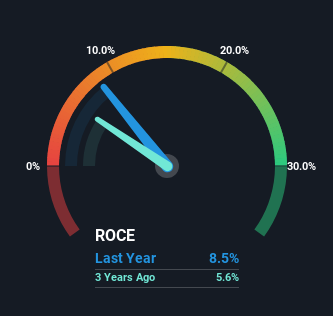If you're looking for a multi-bagger, there's a few things to keep an eye out for. Firstly, we'll want to see a proven return on capital employed (ROCE) that is increasing, and secondly, an expanding base of capital employed. Ultimately, this demonstrates that it's a business that is reinvesting profits at increasing rates of return. However, after investigating Energa (WSE:ENG), we don't think it's current trends fit the mold of a multi-bagger.
Return On Capital Employed (ROCE): What Is It?
If you haven't worked with ROCE before, it measures the 'return' (pre-tax profit) a company generates from capital employed in its business. The formula for this calculation on Energa is:
Return on Capital Employed = Earnings Before Interest and Tax (EBIT) ÷ (Total Assets - Current Liabilities)
0.085 = zł1.7b ÷ (zł30b - zł11b) (Based on the trailing twelve months to September 2023).
Therefore, Energa has an ROCE of 8.5%. On its own, that's a low figure but it's around the 9.7% average generated by the Electric Utilities industry.
View our latest analysis for Energa

While the past is not representative of the future, it can be helpful to know how a company has performed historically, which is why we have this chart above. If you'd like to look at how Energa has performed in the past in other metrics, you can view this free graph of past earnings, revenue and cash flow.
What Can We Tell From Energa's ROCE Trend?
There hasn't been much to report for Energa's returns and its level of capital employed because both metrics have been steady for the past five years. Businesses with these traits tend to be mature and steady operations because they're past the growth phase. So unless we see a substantial change at Energa in terms of ROCE and additional investments being made, we wouldn't hold our breath on it being a multi-bagger.
Another point to note, we noticed the company has increased current liabilities over the last five years. This is intriguing because if current liabilities hadn't increased to 36% of total assets, this reported ROCE would probably be less than8.5% because total capital employed would be higher.The 8.5% ROCE could be even lower if current liabilities weren't 36% of total assets, because the the formula would show a larger base of total capital employed. So while current liabilities isn't high right now, keep an eye out in case it increases further, because this can introduce some elements of risk.
In Conclusion...
We can conclude that in regards to Energa's returns on capital employed and the trends, there isn't much change to report on. Unsurprisingly, the stock has only gained 4.6% over the last five years, which potentially indicates that investors are accounting for this going forward. So if you're looking for a multi-bagger, the underlying trends indicate you may have better chances elsewhere.
If you want to continue researching Energa, you might be interested to know about the 1 warning sign that our analysis has discovered.
While Energa isn't earning the highest return, check out this free list of companies that are earning high returns on equity with solid balance sheets.
Valuation is complex, but we're here to simplify it.
Discover if Energa might be undervalued or overvalued with our detailed analysis, featuring fair value estimates, potential risks, dividends, insider trades, and its financial condition.
Access Free AnalysisHave feedback on this article? Concerned about the content? Get in touch with us directly. Alternatively, email editorial-team (at) simplywallst.com.
This article by Simply Wall St is general in nature. We provide commentary based on historical data and analyst forecasts only using an unbiased methodology and our articles are not intended to be financial advice. It does not constitute a recommendation to buy or sell any stock, and does not take account of your objectives, or your financial situation. We aim to bring you long-term focused analysis driven by fundamental data. Note that our analysis may not factor in the latest price-sensitive company announcements or qualitative material. Simply Wall St has no position in any stocks mentioned.
About WSE:ENG
Energa
Engages in the generation, distribution, trading, and sale of electricity and heat in Poland.
Proven track record and fair value.
Similar Companies
Market Insights
Community Narratives



